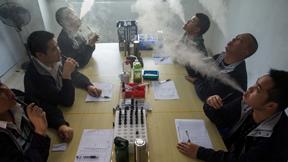
BEIJING: With 90 per cent of the world’s e-cigarettes being made in China, health experts have warned that poorly manufactured devices can vaporize heavy metals and carcinogens alongside the nicotine, harming the users.
This year, Chinese manufacturers are expected to ship more than 300 million e-cigarettes to the US and Europe, where they will reach the shelves of Walmart, 7-Eleven stores, gas station outlets and so-called vaping shops.
The devices have become increasingly popular, particularly among young adults, and yet hundreds of e-cigarette manufacturers in China operate with little oversight, The New York Times reported.
Experts say flawed or sloppy manufacturing could account for some of the heavy metals, carcinogens and other dangerous compounds, such as lead, tin and zinc, that have been detected in some e-cigarettes.
One study found e-cigarette vapor that contained hazardous nickel and chromium at four times the level they appear in traditional cigarette smoke; another found that half the e-cigarettes sampled malfunctioned and some released vapor tainted with silicon fibers.
There have also been reports in the US of e-cigarettes that exploded after a lithium ion battery or electric charger overheated, causing burns.
“We need to understand what e-cigarettes are made of,” says Avrum Spira, a lung specialist at the Boston University School of Medicine, “and the manufacturing process is a critical part of that understanding.”
A review by The Times of manufacturing operations in Shenzhen, a booming city in southern China, found that many factories were legitimate and made efforts at quality control, but that some were lower-end operations that either had no safety testing equipment or specialized in counterfeiting established brands, often with cheaper parts.
Chinese companies were the first to develop e-cigarettes, and that happened in a regulatory void. In the US, the Food and Drug Administration (FDA) has just begun to move toward regulating e-cigarettes, working on rules that would force global producers, in China and elsewhere, to provide the agency with a list of ingredients and details about the manufacturing process.
But analysts say setting those rules and new manufacturing guidelines could take years. In the meantime, Chinese factories are quickening the pace, hoping to build profits and market share before regulatory scrutiny arrives and most likely forces many e-cigarette makers to close.-PTI




